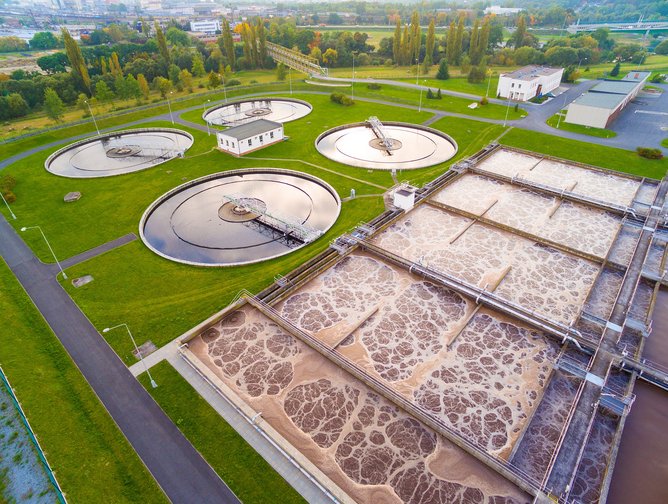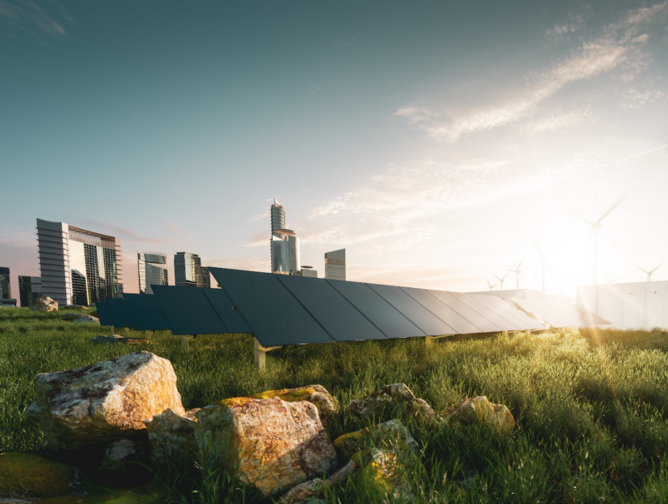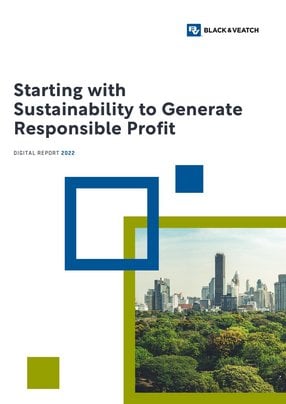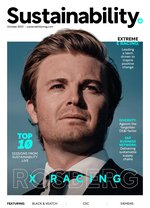Starting with Sustainability to Generate Responsible Profit
ESG is critical for Black & Veatch, internally and externally
Amanda O’Dell and Ajay Kasarabada of Black & Veatch are making sustainability known across the company and among its construction and engineering clients
Sustainability has been ingrained in Black & Veatch’s DNA for more than a century, whose strong environmental credentials predate the term ‘carbon footprint’ by 70 years.
Black & Veatch is an employee-owned global engineering, procurement, consulting and construction company, headquartered in Overland Park, Kansas, with a century’s work in sustainable infrastructure.
“Since 1915, we have helped our clients improve the lives of people around the world by addressing the resilience and reliability of their most important infrastructure assets,” says Amanda O’Dell, Corporate Sustainability Manager.
A lot has changed since Black & Veatch was founded, not least the meaning of the term ‘value’. Back then, it meant merely the cost of a product or service. But in today’s world, ‘value’ references a firm’s reputation and behaviour as much as it does price tags.
ESG compliance is of monumental importance, with investors, stakeholders and customers all expecting best practice corporate behaviour in this area.
"We’re advocates of environmental stewardship,” says O’Dell, who has the task of ensuring compliance across the business. “This includes optimal use of natural resources and ESG management across business operations.” O’Dell also says ESG and diversity, equity and inclusion (DEI) both shape relationships with suppliers.
“Providing equal access to all types of suppliers is important at a very human level, but it also has a profound socio-economic impact,” says O’Dell.
She goes on to cite data suggesting that while women and those from marginalised communities are well represented in the realm of small firms, this is not the case in the wider business world.
“While 99% of US companies meet the definition of a small business, 50% of those are either woman or minority-owned — representing only 7% of the total revenue of all US businesses.”
Addressing this is critical for Black & Veatch and something it echoes through its engagements with its clients. Not only does this have an impact on underrepresented groups and brings small businesses into the fold, but diversity creates a more competitive supply chain — more resilient to industry disruptions — and breeds innovation among businesses.
Extending sustainability commitments to clients
With its long track record of sustainability experience, Black & Veatch is well-placed to support clients on their ESG journeys.
The company’s Director of Environmental Solutions, Ajay Kasarabada, handles client-focused ESG strategy, helping businesses embed compliance into commercial processes.
“When it comes to sustainability on the project execution side, we can test on our own projects first, and then share what we learned with our clients,” says Kasarabada. “We implement our own policies and processes for designing and engineering projects, as well as how we procure equipment and use it in construction.” This provides Black & Veatch with first-hand insights to share, allowing its clients to leverage sustainable sourcing with a procurement and construction strategy that has already been applied in their industry. The result: manufactured goods are produced with lower carbon emissions, staff are treated fairly throughout the supply chain, and transport emissions are reduced.
Kasarabada also notes there has been a shift away from the previous industry strategy — cost optimisation and profitability — to a triple-bottom-line approach that also includes a social and environmental impact.
“This now comprises a major portion of our client process,” he says. “Profit is important, but there is more emphasis on the importance of having a sustainable mindset towards construction.”
He adds: “The biggest challenge is investment in sustainability and ESG. This does not directly result in a price increase of suppliers’ products, because price is dictated by market forces. They have to think about how they justify cost in terms of impact.”
Creating a resilience strategy that aligns with client needs
Cindy Wallis-Lage and Kristie Deiuliis of Black & Veatch on how resilience comes from an integrated approach to ESG
Sustainability goes beyond ESG; it has become a staple for internal and external business operations. It is an ongoing process, one that relies on continuous outreach, education, and partnerships aligned with ESG goals.
As a trusted group of advisors and innovative thinkers, Black & Veatch’s approach to client support comes from within the business as ESG takes precedence over all aspects of its operations.
“It's beyond just focusing on renewable energy and clean fuels as energy sources,” says Cindy Wallis-Lage, Executive Director, Sustainability and Resilience at Black & Veatch. “It also involves looking at water projects, broadband projects, smart cities, environmental projects and food production, such that we are holistically driving sustainability improvements.”
An integrated sustainability strategy creates resilience
Sustainability is a corporate social responsibility, but resilience is something that companies can and should integrate into their operations. Black & Veatch offers its clients insights into how they can assess their value chains and make sustainable decisions in EPC with consideration for renewable energy and new technologies, all of which must integrate in alignment with sustainability principles to achieve cost-efficiency and long-term resilience.
“We have an incredibly strong value proposition and services and solutions that help our clients navigate the technology options before they commit to a path forward. An important role Black & Veatch plays in this exploration is to create a strategic and tactical fact base from which our clients can assess commercial viability, risk mitigation and opportunities to monetise their priorities,” says Kristie Deiuliis, Managing Director, Decarbonization Strategy & Planning at Black & Veatch.
The company has a key role to play in supporting its clients and devising its sustainability solutions in-house puts Black & Veatch in a great position to manage the onboarding and overall success. When it comes to making sustainable business decisions, Black & Veatch clients are made aware of the benefits of workforce alignment. This means alignment with their sustainability strategies and their ability to adopt new solutions to facilitate their company’s vision.
“When you ask them to define sustainability, you will get many different answers because we all look at it through the lens of our own experiences,” says Wallis-Lage. To follow up, she explains that organisations must figure out how to “create a common understanding of what they’re trying to achieve at the high level, which is what I’m trying to make sure we’re doing at Black & Veatch.”
Black & Veatch emphasises and demonstrates the importance of a skills audit. Without the necessary skills in place within its clients’ organisations, implementing sustainability transformation will result in them being caught up at the first hurdle — meaning without the necessary skills in the workforce, they will struggle to put their visions in motion.
“To get people to align to sustainability goals, it is really important that we establish the purpose,” says Wallis-Lage. “It involves an understanding of the ‘why’ and then making sure that we're providing all of the skill sets, knowledge and thought leadership that we need to help our clients achieve what they need.”
Over the next 12 months, Black & Veatch will help its clients in this area while leveraging new technologies to ensure alignment of focus across their teams and integrating sustainable principles into their everyday working lives.
Black & Veatch’s sustainable forward-thinking approach
JC Alonzo of Black & Veatch, explains why reactive sustainability is more costly than a forward-thinking approach
The built environment must become more sustainable. For this to happen, more consideration must be given to the design phase of every construction project. Then, design and construction firms can actively shape their industry's operations through a circular economy.
Climate change affects many facets of life, and the built environment is subject to increased risk of natural disasters. As a result, companies must first change their approach to consider the effects of building design for efficiency, resiliency and social and economic impacts.
Organisations are often torn by the cost of sustainable development and stuck in the process of designing first and implementing sustainable initiatives later. Black & Veatch supports clients by encouraging a more proactive approach and puts responsible sourcing and design at the forefront of every project.
A reactive approach to sustainability costs time and money
Organisations struggle with implementation and timing of when to implement sustainability into their projects. JC Alonzo, Senior Environmental Sustainability Specialist at Black & Veatch, says when sustainable principles are applied at the beginning of a project to encourage emissions reduction, localisation of material sourcing, and building energy efficiency, then long-term project costs are optimised.
“We help our clients mature. As their organisational impact awareness matures, they realise that they can incorporate environmental and resilience concerns into their project design and planning phases earlier to build better projects while simultaneously experiencing a minimal increase in project price,” Alonzo says.
Apply sustainability planning to reap the benefits
Black & Veatch is committed to sharing this knowledge and helping clients pre-plan sustainability. Measurement against current and completed projects is one way of educating organisations on what they can achieve — and it’s a clear goal for many of them — but to get to the heart of their goals, Black & Veatch targets ESG at the concept phase.
“Almost all of our clients have statements and reports that set out their goals and efforts, but few have mapped all those goals to include their project impacts,” says Alonzo.
“We introduce them to Envision, an infrastructure rating tool we use to measure and track their resource use, to identify how they can cut their emissions and energy consumption, and then to focus on resilience both in the short- and long-term.”
Aligning projects to company ESG goals means reducing impact on specific classes of individuals, minimising the use of virgin natural resources, eliminating greenhouse gas emissions, and cutting the process of importing water. Also, it’s important to consider waste and the end-of-life procedure for materials as the circular economy influences project design.
“When organisations accept full responsibility for their impacts, I think we're going to see a hopeful, new normal,” says Alonzo. “While this doesn't necessarily end the world's problems, it will help us buy time to innovate and prepare for a future with fewer virgin resources.”
E-mobility is a necessary action for decarbonisation
Maryline Daviaud Lewett from Black & Veatch provides her views on necessary developments in infrastructure and technology as we shift to e-mobility
The switch to battery-electric vehicles and fuel-cell technology is a global conversation right now, and both traditional organisations and newcomers in the transport industry are putting more resources into electrification as a strategy for sustainability. It’s important to understand that the effects of electric vehicles (EVs) apply to all industries beyond traditional automotive brands — much like the overarching topic of sustainability.
Providing the necessary expertise to facilitate the switch for clients, Black & Veatch is working with clients to incorporate electrification into their daily operations. All things are considered — including the challenges of long-distance transport on the ground, overseas and in the air — as well as the required infrastructure to support localised transport, which is transitioning towards a more systematic approach.
As Director of Business Development at Black & Veatch, Maryline Daviaud Lewett works with clients to advise on all aspects of transitioning to zero-emission vehicles, from financing projects to executing major infrastructure developments.
“We need to build the charging and clean fueling infrastructure to support the vehicles. Our clients are often surprised by how long that can take,” Daviaud Lewett says.
While electrification is paramount in the emissions crunch, the delayed delivery of EVs plays into the hands of developers as there is still work to be done before charging and infrastructure are ready for fully-electric transport.
“How long the infrastructure takes to build depends on the size of the hub and charging system, as well as how many hubs their fleets need. Eight-to-nine months is a minimum, ranging as long as 18 to 24 months. Access to power and adequate power supply are vital to EV charging sites and if not present, can take time to develop,” says Daviaud Lewett.
“More recently, material and procurement, in general, have experienced much longer lead times to get the necessary equipment on site.”
Taking care of electrification at the source
Sourcing is a key factor in adopting alternative mobility methods. While the application of autonomous driving provides efficiency benefits, the underlying issue of decarbonisation is renewable energy. Sourcing renewable energy is a critical part of decarbonising the energy supply chain and must be dealt with to ensure that charging is a truly sustainable solution. Alternatively, hydrogen shows major benefits for decarbonisation, particularly in heavy goods transport.
“We are looking at the future of zero emissions involving a mix of technologies,” says Daviaud Lewett. “There’s no single technology that will dominate; different technologies are applicable to different market segments.”
Technology is also a key enabler of decarbonisation, with applications in energy management and the distribution of fleet charging. Energy management through technology means reliance on automation and artificial intelligence (AI) to manage the vehicles on the road and their energy usage. Charge distribution is displayed through last-mile delivery and software solutions provide welcome benefits to logistics firms as they make the transition to electric.






